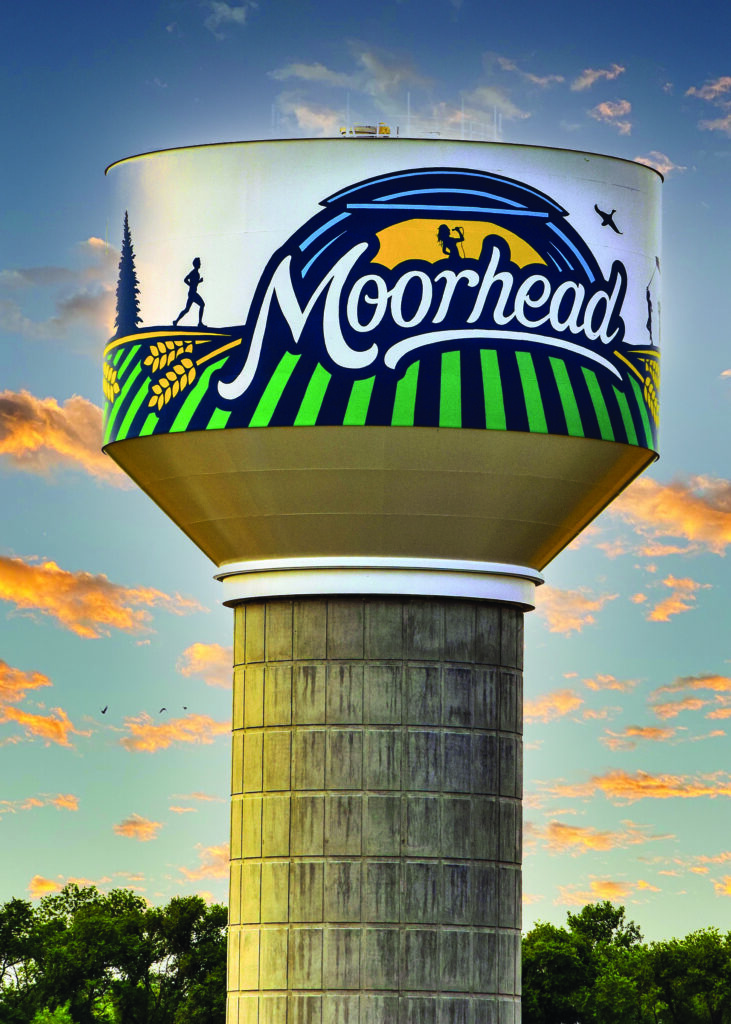
The design of Moorhead’s new southside water tower reflects a variety of local activities. (Photo/Russ Hanson)
Nancy Edmonds Hanson
In this driest summer of more than 20 years, the subject of water has people looking up in Moorhead.
An Indiana-based contractor has put the finishing touch on the city’s fourth and newest water tower. The $2.6 million structure punctuates the level landscape at the southern end of the Village Green golf course, towering above it at 4255 28th St. S. Meanwhile, a Wisconsin crew is about to begin a full $1 million rehabilitation of its closest neighbor, the tower standing just north of Interstate 94 near the 20th Street interchange.
Both towers are key to Moorhead Public Service’s mission to provide top-quality water to the city’s residents. Adding the newest tower – the city’s fourth – was prompted by dramatic growth on the south side. The I-94 tower was last refreshed in 1995. The two structures were initially scheduled for 2020 but delayed due to the pandemic.
The 28th Street tower sports a new look. Instead of the bulbous shape of the other three, the tank that tops it is a welded steel cylinder 62 feet in diameter resting above a concrete pedestal. MPS water manager Marc Pritchard explains the composite elevated tank is increasingly popular for new towers, requiring a smaller construction footprint and lower maintenance cost.
The Village Green tank is adorned with a belt of art depicting the area. Designed by local graphic artists Stephen Dorsey and Jack Lunde, it portrays those who walk and play beneath it – a golfer, of course, as well as a jogger, a dog and its human, and two children flying kites. Stalks of wheat and gold-and-green windrows surround the “buckle,” a script “Moorhead” topped with a singer belting out a song on the Bluestem stage.
Artists Jack Lunde and Stephen Dorsey designed art for the new tower, as well as those in Woodlawn Park and Oakport. Graphic artist Michelle Churchill of Fargo was selected for the I-94 project that, when complete this fall, will be seen by an estimated 40,000 drivers every day.
“Our planning department took charge of that one,” Pritchard says. “The competitive process drew more than a dozen applicants and a wide variety of ideas. Some were definitely out of the box – an optical illusion, for example and a proposal to project the art onto the tower. In the end, we decided to go with something more on the traditional side.” It’s simpler, too, than the others; he explained the committee didn’t want to distract drivers whizzing by on the highway.
While water towers and public art make for pleasant news, Pritchard and MPS general manager Travis Schmidt have their own eyes on a more challenging topic. When the Minnesota Department of Natural Resources issued mandatory water restrictions on July 16, they implemented Stage One of Moorhead’s water supply protocol.
The state announcement was timed well with their own observations of the growing drought. Moorhead’s plan dictates restrictions when the Red River slows to 150 cubic feet per second or less – a level that it had just reached. “If the state hadn’t come out with its order, we would have implemented restrictions independently,” Schmidt notes.
Restrictions now apply to both Moorhead and Dilworth, which purchases water from the Moorhead water plant. Watering and car washing are now limited to alternate days, with households turning on the hose on even- or odd-numbered days coinciding with their house numbers. In addition, all non-essential water use for lawns, including watering of city park space and athletic spaces, is limited to the hours of 8 p.m. through 8 p.m. due to excessive evaporation during daylight hours.
Some watering is exempt from the rule. That includes gardens, flowers, newly planted trees and shrubs and newly planted lawns. Violating the rules could lead to fines.
Moorhead currently takes about 80% of its water from the Red River. The remaining 20% of what’s coming from faucets today is being drawn from the Buffalo Aquifer, the deep, cold stream of water that lies 150 feet underground.
The blending has been undertaken, not specifically to conserve the diminishing flow of the Red, but to cool its torrid temperature to a level that aids the ozone disinfection staging at the water plant. Pritchard says, “The river is at 77 degrees or so right now. We’ve never seen temperatures get so high so fast. Usually it gets there by the end of August or early September. This year, we’ve been seeing it since June.”
During the last dry spell in the 1980s, water usage drew down the aquifer to a dramatically low level. However, decades of wetter-than-normal weather, Pritchard and Schmidt say, have allowed it to fully recharge – that, and construction of the water plant on Highway 75 in 1994, which helps conserve the vital resource. “It’s reasonable to expect we’ll see its level go down slightly again now,” they agree. “That’s why we’re pumping only enough to cool the river water.”
But there’s plenty of water underfoot to slake Moorhead and Dilworth’s thirst, at least for a good number of years to come. The Red River stands at 13.8 feet right now, leaving several feet to go before it becomes a concern for the communities that depend on it. “Even if it were run dry,” the water manager says, “there’s more than plenty enough to meet our needs.”


